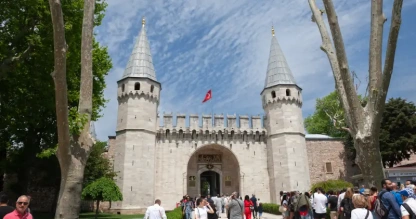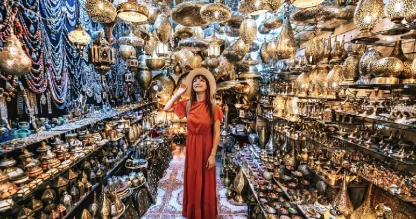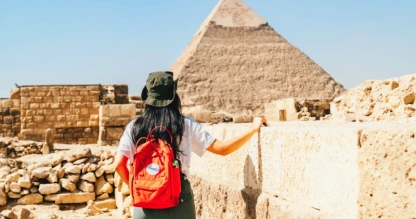
Visit Topkapi Palace Museum
Topkapi Palace is a historic palace located in the heart of Istanbul, Turkey. Built in the 15th century by Sultan Mehmed II following the Ottoman conquest of Constantinople, it served as the primary residence and administrative center of the Ottoman sultans for nearly 400 years.
Overlooking the Golden Horn and the Bosphorus, the palace complex is an outstanding example of Ottoman architecture, blending Islamic, Byzantine, and traditional Turkish elements. Today, Topkapi Palace operates as a museum, housing priceless collections of imperial treasures, manuscripts, religious relics, and artworks that reflect the grandeur and sophistication of the Ottoman Empire. It is a must-visit destination for anyone exploring Istanbul on Turkey tours.
Why Topkapi Palace Istanbul is a must-visit
Topkapi Palace stands majestically above the Bosphorus, Golden Horn, and Sea of Marmara as one of Turkey's most fascinating historical treasures. This grand complex gives visitors a unique window into the Ottoman Empire's golden age. Each year, millions of tourists walk through its historic halls and gardens.
Historical role as the Ottoman seat of power
The palace was the heart of Ottoman rule for almost four centuries, from 1478 until 1856. Sultan Mehmed II built it after conquering Constantinople. This was more than just a royal home - it served as the administrative center where the Imperial Council made policies to govern the vast Ottoman state.
The Imperial Council Chamber in the Second Courtyard saw vital decisions that shaped history across three continents. Mehmed II's administrative hierarchy showed in the palace's design, as each grand gate led visitors closer to the power's inner circle. Walking these grounds today helps us understand Ottoman architecture and the empire's complex political system.
Architectural blend of Islamic and European styles
Topkapi's unique architectural character sets it apart from other palaces in Europe and the Islamic world. Instead of one massive building, it has many low structures arranged around courtyards, linked by galleries and passages. The palace beautifully combines Islamic, Byzantine, Ottoman, and European influences. Its design follows traditional Turkish architectural principles but includes Persian and Byzantine decorative elements. The complex grew naturally over centuries, with major updates after the 1509 earthquake and 1665 fire.
UNESCO World Heritage recognition
Topkapi Palace became part of Istanbul's Historic Areas in 1985, earning UNESCO World Heritage status. This honor highlights its remarkable cultural importance and architectural achievements. The palace adds to Istanbul's stunning skyline, created by "the creative genius of Byzantine and Ottoman architects".
UNESCO recognized its outstanding value as proof of centuries-old connections between Europe and Asia. National conservation laws protect the site, and ongoing preservation work keeps this cultural landmark intact for future visitors. The Historic Peninsula's impressive skyline with Topkapi Palace remains protected through careful planning.

Top highlights to explore inside the palace
The Topkapi Palace museum's vast grounds hold remarkable spaces that show how Ottoman imperial life worked. Each chamber and hall tells a story of the empire's magnificence and its sophisticated rule.
The Harem: Power behind the walls
The famous Harem served as more than the sultan's private space—it became a hub of power and politics with over 300 rooms. This private complex became home to the sultan's mother, wives, concubines, and children who lived by strict hierarchy.
The Valide Sultan (Queen Mother) had significant power and managed the entire Harem while often handling state matters. Visitors today can see just a few of these rooms, but they showcase beautiful İznik tiles, tortoiseshell decorations, and mother-of-pearl inlays.
The Imperial Council Hall
The Imperial Council Hall stood as the empire's command center. Leaders shaped state policies and held diplomatic meetings here. The hall's clever acoustic design lets people hear even whispers from across the room—a feature built to monitor conversations. The sultan watched meetings through a golden grille high up on the wall and stepped in when needed. The council met four days each week, with specific days set aside for military affairs, finances, legal cases, and administration.
The Hidden Kitchens and porcelain collection
The palace kitchens stand as a marvel of organization that could feed up to 5,000 people each day. About 800 staff members worked here in ten domed buildings with 20 large chimneys.
These kitchens now display one of the world's best collections of Chinese and Japanese porcelain, featuring over 10,000 pieces from different dynasties. The Chinese celadon pieces draw special attention—sultans valued them because they believed these pieces would change color if touched by poisoned food.

Hidden gems and lesser-known spots
Istanbul Topkapi Palace holds secret spaces that most visitors never see beyond its grand halls and iconic chambers. These hidden corners show us the private world of Ottoman royal life and how the empire was governed.
The Gilded Cage and its political purpose
The Harem section contained the Kafes or "Gilded Cage" - luxurious quarters that served as a prison for potential heirs to the throne. This system replaced a more brutal tradition where new sultans executed their brothers to prevent power struggles. Young princes entered the Kafes at age eight and stayed until death or coronation. The comfortable surroundings couldn't prevent psychological damage from years of isolation.
The Circumcision Room and royal ceremonies
Sultan Ibrahim I built the summer kiosk known as the Circumcision Room (Sünnet Odası) in 1640. Beautiful blue Iznik tiles with floral motifs decorated this space where young Ottoman princes' circumcision ceremonies took place.
These celebrations lasted 10-15 days but sometimes went on for 55 days. Palace surgeons also circumcised thousands of boys from poor families during these festivities. Each boy received gifts of clothing, gold coins, and toys.

The Terrace of Sultan Ibrahim I
The Fourth Courtyard's terrace provides stunning views of the Bosphorus and Golden Horn. Ottoman palace garden design shaped this space during the 17th and 18th centuries, creating strategic viewpoints. The terrace's gilded İftar Pavilion became the sultan's traditional spot to break Ramadan fasts at sunset. Its distinctive ridged cradle vault with gilded roof showed architectural breakthroughs that combined Chinese and Indian influences. Today, this scenic terrace is a highlight for visitors exploring the Topkapi Palace Museum as part of their Turkey tour packages.
The Privy Chamber of Murad III
Legendary architect Sinan created the Harem's oldest and most splendid surviving room in 1579 - the Privy Chamber of Murad III. This room served as both a private apartment and reception hall where vital decisions shaped the empire's future.
The chamber's magnificent dome symbolized Ottoman rule's permanence, while vibrant Iznik tiles covered its walls. A calligraphic band showing the Quranic Throne Verse runs around the room. The chamber's two-tiered fountain produced flowing water sounds that prevented anyone from overhearing sensitive conversations.

Tips for visiting Topkapi Palace
The Topkapi Palace museum stands as an Ottoman treasure, and you'll need some smart planning to get the most out of your visit. Let me share some practical tips about this magnificent complex.
Best time to visit
The palace opens at 9am, which is perfect to avoid crowds. Spring months (April-May) or fall (September-November) offer the best visiting conditions. You'll find Monday mornings quieter, but weekend lines can stretch beyond 40 minutes.
Guided tours vs. self-guided
Professional guides give you historical insights and quick answers to your questions, though they cost more. The self-guided option comes with audio guides in several languages. Most visitors say audio guides provide enough information without group tour restrictions.
What to wear and bring
The Sacred Relics Chamber needs modest dress - shoulders and knees must be covered. You should wear comfortable shoes since you'll walk extensively. Don't forget your headphones, a charged phone, and some cash for small purchases.
Nearby attractions to combine with your visit
Hagia Sophia, the Blue Mosque, and Basilica Cistern sit just minutes away from Topkapi Palace Istanbul. You might enjoy a stroll through the adjacent Gülhane Park or visit the Istanbul Archeological Museums behind the palace. Combination tickets make it easy and cost-effective to see multiple sites.

FAQS
Q1. What is Topkapi Palace?
Topkapi Palace (Topkapı Sarayı) is a historic palace in Istanbul that served as the home and administrative center of the Ottoman sultans for nearly 400 years.
Q2. When was Topkapi Palace built and by whom?
It was built by Sultan Mehmed II after the conquest of Constantinople, starting around 1460 and completed by 1478.
Q3. What can visitors see inside Topkapi Palace today?
Visitors can explore the Harem, Treasury, Palace Kitchens, and see imperial treasures, religious relics, and historical artifacts.
Q4. Why is Topkapi Palace important in Ottoman history?
It was the center of Ottoman power, where sultans ruled, diplomats met, and major decisions were made, reflecting the empire’s culture and wealth.
Q5. Where is Topkapi Palace located and how can it be visited?
It sits on Seraglio Point in Istanbul’s Sultanahmet district, overlooking the Bosphorus, and is open to the public as the Topkapi Palace Museum.
Discover Hagia Sophia and the best of Turkey on our Turkey Tours and Middle East trips!














